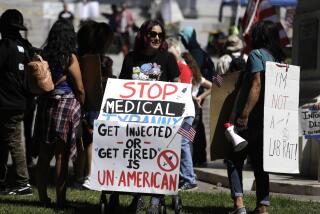Clashing portraits of anthrax suspect
FREDERICK, MD. — Inside Ft. Detrick’s cloistered high-security laboratories, Bruce E. Ivins was regarded as a seasoned researcher and an affable, if slightly odd, colleague. He showed up for work in thrift-store clothes, gobbled down powdered milk and foul-smelling lunches of fish and other foodstuffs layered in jars. Sometimes he abruptly dropped to the floor to juggle balls while lying on his back.
That was “just Bruce,” colleagues would say, shaking their heads. It was his endearing qualities that were recalled Saturday at a memorial service for the once-unknown scientist.
But there was another Bruce, one who sometimes lashed out in disjointed hostility. Starting in 1982 and continuing through last year, Ivins obsessively contacted a fellow University of North Carolina graduate student he’d known in the 1970s. The woman was a member of the Kappa Kappa Gamma sorority, which FBI officials said may have been “linked to location of anthrax mailings” in Princeton, N.J.
The object of Ivins’ fixation was Dr. Nancy L. Haigwood, who now directs the Oregon National Primate Research Center in Portland. Haigwood confronted Ivins in 1982 after she found her sorority’s initials scrawled in red paint on her fiance’s car and the sidewalk and gate of the condominium where she lived.
Ivins denied involvement. But for 25 years after that episode, Haigwood said, he regularly bombarded her with “creepy” letters and then e-mails, asking about her life and referencing details about her family that she had never discussed with him.
Shortly after the anthrax letters were mailed in late 2001, Haigwood said, Ivins included her in a group e-mail bragging about his work with the toxic spores. He sent along photographs of himself working in his Ft. Detrick lab.
“This is someone who thinks he can do anything to anybody at any time,” Haigwood said.
The clashing portrayals that emerge of an accomplished biowarfare expert and obsessive oddball chart the downward trajectory of a veteran scientist whose eccentricities seemingly blossomed into madness inside one of the U.S. government’s most secure installations.
After his apparent suicide late last month, he was accused of murdering five people with the anthrax bacterium he had spent his life trying to protect people from by developing better vaccines.
On Saturday, several hundred people filled St. John the Evangelist Catholic Church in Frederick for a memorial service celebrating Ivins’ life. Friends, colleagues and family remembered the scientist as a generous and talented man with a keen sense of humor. They spoke about his love of music and Gary Larson’s “The Far Side” cartoons, about his enthusiasm for helping others and about his mischievous jokes -- including the remote-control device he kept in his office that made flatulence sounds.
The circumstances of Ivins’ death went unmentioned inside St. John.
But outside the spare white and gray house of worship, a cordon of police officers and a phalanx of television cameras acted as silent reminders of the accusations the Justice Department has leveled against Ivins.
The closest acknowledgment of the controversy came from Ivins’ younger brother Charles, who ended his remarks by addressing his dead brother directly.
“I’ll miss you, buddy,” he said. “I’m glad your torment is over.”
Ivins’ wife and two children did not speak during the memorial. His wife, Diane, her hair cropped short since her husband’s death, was composed throughout the ceremony and afterward greeted friends with hugs.
Ivins’ son, Andy, 24, was subdued in a dark suit and shook hands with friends at the end of the service. Andy’s twin sister, Amanda, wiped away tears and hugged friends, her right wrist in a cast.
The priest leading the music-filled service asked God to forgive “Bruce’s sins and failings” and led the congregation in two Bible readings that he said were chosen by Diane Ivins.
One, from St. Paul’s letters to the Corinthians, emphasized that only God can judge man. The other was from the story of Job.
--
Chronicling his decline
Ivins himself provided a ghoulish commentary on his disintegrating inner self. Prescribed a mix of psychotropic medications from 2000 to 2006 for unspecified mental illness, according to FBI documents, Ivins e-mailed an eerie poem to a friend in December 2001: “Hickory dickory Doc! Bruce and this other guy, sitting by some trees, exchanging personalities. It’s like having two in one. Actually it’s rather fun!”
Last week, one anthrax expert suggested that Ivins’ deteriorating mental state after 2000 might have been affected by the annual vaccinations he would have received over his 28-year career to protect against infection by the potent anthrax spores he cultivated. Ironically, much of Ivins’ research was aimed at developing a new vaccine.
Meryl Nass, a Maine physician and expert on the anthrax vaccine, said Ivins complained to her in 1998 that he was suffering from a blood disorder he worried might be a side effect of anthrax vaccinations.
Nass suggested last week that Ivins may have had psychological side effects as well, especially if the vaccines interacted with the antipsychotic drugs he took over the last decade.
The old vaccine has been linked to psychological effects in a report by the National Academies of Science Institute of Medicine. Examining active-duty military personnel who received shots from 1998 to 2000, the study found that the diagnosis rate for psychoses and other personality disorders more than tripled after the vaccinations.
Friends of Bruce Ivins say he was a frail man who simply unraveled under the extreme stress of the government’s pressure-cooker investigation. “Their science is suspect, but even if they had done a better job, it’s still the wrong guy,” said Dr. W. Russell Byrne, who was Ivins’ supervisor from 1998 through 2000.
At home and around Frederick, Ivins seemed the model citizen. Living in a cramped white frame house across the street from the walled-off military installation, Ivins played keyboards during Sunday folk Mass concerts at St. John. He taught lifesaving courses. He juggled for delighted children at the county fair.
At his lab table, Ivins was regarded as a top-notch researcher who excelled in “spore prep,” the cultivation of virulent strains of anthrax for use in efforts to find a cure that could be used by American soldiers in the event of a mass biowarfare attack.
Ivins was deemed promising when he joined Ft. Detrick’s research staff in 1980. Microbiologist John W. Ezzell, who was on the hiring committee that brought Ivins into the U.S. Army Medical Research Institute of Infectious Diseases (USAMRIID), laughed at his 1970s-era bell-bottom pants but was impressed by his “teamwork. That’s what we were looking for.”
--
Troubled childhood
Ivins came from Lebanon, Ohio, where he had impressed his small-town high school teachers with his acuity in biology and chemistry. His chemistry teacher, Dean Deerhake, said Ivins was “very intelligent but pretty much a loner.”
At home in Lebanon, there were indications of a troubled existence. Thomas Ivins, the scientist’s estranged older brother, said that Bruce was alternately “coddled” and punished by a mother who kept him “attached to her apron strings.”
Bruce Ivins talked little about his family life with co-workers. He partnered with his wife for the folk Masses at St. John -- while he played the keyboards, she sang.
Their daughter, Amanda, lives in Hagerstown, Md., 25 miles northwest of Frederick. Reached last week, she indicated that she would like to talk about her father eventually but said: “When I do, I will do it with my lawyer. . . . I haven’t been charged with anything, but I want my lawyer at my side when I talk about my dad.”
Her father seemed most at home inside Building 1425, where he worked long hours in his office and in the high-security labs where anthrax spores were cultivated.
When the anthrax letters surfaced in September and October of 2001, killing five people from New York to Florida, Ivins was one of 80 scientists assigned to investigate the source of the highly weaponized spores. They worked around the clock, analyzing more than 33,000 samples.
“He had a reputation for being trusted with these materials,” said Ezzell, whose diagnostics division led the search.
But in April 2002, near the end of the testing frenzy, USAMRIID revealed that anthrax contamination had been found in an office and changing room outside a secure area, sparking a partial evacuation of the building. The leak was traced to Ivins, who admitted that there also had been a December 2001 leak inside his office -- a serious violation of protocol -- which he had tried to contain by spreading bleach on the affected area.
As the FBI and USAMRIID’s scientists narrowed their search for the anthrax culprit, they turned to Ft. Detrick itself as the source. Many researchers were forced to take polygraph tests, though it remains unclear whether Ivins was one of those scrutinized.
By summer of last year, Ivins was the prime target. FBI agents parked their cars outside his home, so close to his driveway that Ivins had trouble pulling up in his faded red Dodge van, recalled neighbor Robert Duggan.
At work, he wept at his desk. Voice quavering, he told one colleague: “These guys aren’t letting up. Sometimes they’re following me home. They won’t let me breathe.”
In November, after he was medically committed to a Maryland mental health center, Ivins’ security clearance was canceled, a crushing blow.
In May, Ivins sent an e-mail to the co-worker, saying he intended to retire in September. “We’re not well-paid, and we do what we do because it’s interesting,” Ivins wrote. “If you take away that, there’s no reason to stay in science.”
--
david.zucchino@latimes.com
nicole.gaouette@latimes.com
Times staff writers David Willman in Washington and Charles Piller in San Francisco and researcher Janet Lundblad in Los Angeles contributed to this report.
More to Read
Sign up for Essential California
The most important California stories and recommendations in your inbox every morning.
You may occasionally receive promotional content from the Los Angeles Times.











